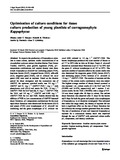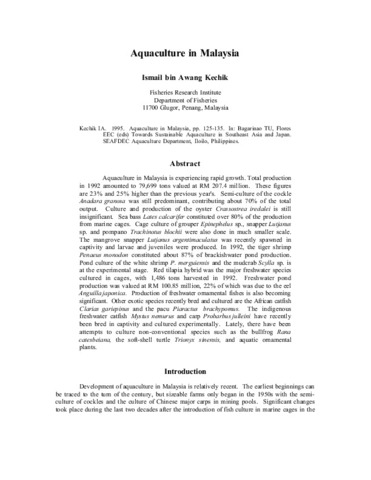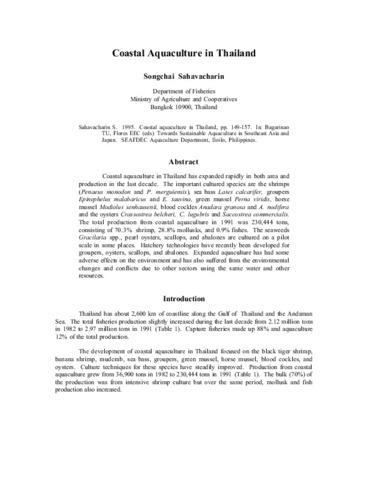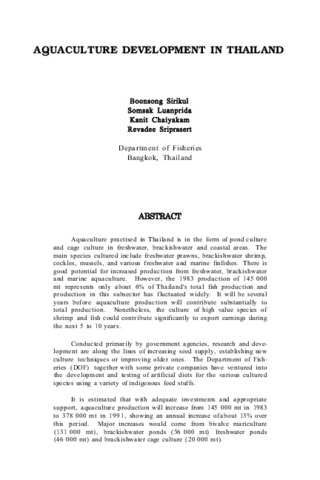Optimization of culture conditions for tissue culture production of young plantlets of carrageenophyte Kappaphycus
Share
Abstract
To improve the production of Kappaphycus plantlets in tissue culture, optimum media concentrations of an Ascophyllum nodosum extract (Acadian Marine Plant Extract Powder, AMPEP), plant growth regulators (PGR), pH–temperature combinations, and explant density were determined. Kappaphycus alvarezii var. tambalang purple (PUR), kapilaran brown (KAP), vanguard brown (VAN), adik-adik (AA), tungawan green (TGR), and K. striatum var. sacol green (GS) were used as explants. Based on the shortest period for shoot emergence and the economical use of AMPEP, the optimum enriched media was 3.0 mg L−1 AMPEP and 0.1 mg L−1 AMPEP + PGR 1 mg L−1 each phenylacetic acid (PAA) and zeatin for PUR, 1.0 mg L−1 AMPEP + PGR for KAP and GS, 0.1 mg L−1 AMPEP + PGR for VAN, and 3.0 mg L−1 AMPEP and 0.001 mg L−1 AMPEP + PGR for AA and TGR. Results showed that the addition of PGR to low concentrations of AMPEP hastened shoot formation. pH–temperature combinations for the most rapid shoot formation were determined for the brown (KAP) and purple (PUR) color morphotypes of K. alvarezii var. tambalang and the green morphotype of K. striatum var. sacol (GS) cultured in 1.0 mg L−1 AMPEP + PGR. The brown morphotype produced the most number of shoots at pH 7.7 at 20°C after as little as 20 days. Purple K. alvarezii showed an increased shoot formation at pH 6.7 at 25°C and the green K. striatum morphotype at pH 8.7 at 25°C. The optimum number of explants added to the culture media was also determined for tungawan green (TGR), brown (KAP), and tambalang purple (PUR) varieties of K. alvarezii in 1.0 mg L−1 AMPEP + PGR. The number of explants and the volume of the culture media combination were also tested. The highest average number of shoots formed occurred in two explants:1 mL culture media (2:1) for KAP and PUR (35.00% and 16.67%, respectively) and 1 explant: 2 mL culture media for the TGR (100.00%) with a range of 0.5–3.0 mm shoot length after 40 days in culture. The earliest shoot formation was observed after 21 days for the brown and 9 days for both the green and purple color morphotypes of Kappaphycus, in all densities investigated. This indicated that within the range tested, the density of explants did not have a significant effect on the rate of shoot formation but did influence the average number generated from the culture. The rate of production of new and improved Kappaphycus explants for a commercial nursery stock was improved through the use of AMPEP with optimized culture media pH, temperature, and density conditions.
Suggested Citation
Yunque, D. A. T., Tibubos, K. R., Hurtado, A. Q., & Critchley, A. T. (2011). Optimization of culture conditions for tissue culture production of young plantlets of carrageenophyte Kappaphycus. Journal of Applied Phycology , 23(3), 433-438. https://doi.org/10.1007/s10811-010-9594-7
Subject
Collections
- AQD Journal Articles [1249]
Related items
Showing items related by title, author, creator and subject.
-
Aquaculture in Malaysia
Kechik, Ismail bin Awang. (Aquaculture Department, Southeast Asian Fisheries Development Center, 1995)Aquaculture in Malaysia is experiencing rapid growth. Total production in 1992 amounted to 79,699 tons valued at RM 207.4 million. These figures are 23% and 25% higher than the previous year's. Semi-culture of the cockle ... -
Coastal aquaculture in Thailand
Sahavacharin, Songchai (Aquaculture Department, Southeast Asian Fisheries Development Center, 1995)Coastal aquaculture in Thailand has expanded rapidly in both area and production in the last decade. The important cultured species are the shrimps (Penaeus monodon and P. merguiensis), sea bass Lates calcarifer, groupers ... -
Aquaculture development in Thailand
Sirikul, Boonsong; Luanprida, Somsak; Chaiyakam, Kanit; Sriprasert, Revadee (Aquaculture Department, Southeast Asian Fisheries Development Center, 1988)Aquaculture practised in Thailand is in the form of pond culture and cage culture in freshwater, brackishwater and coastal areas. The main species cultured include freshwater prawns, brackishwater shrimp, cockles, mussels, ...




